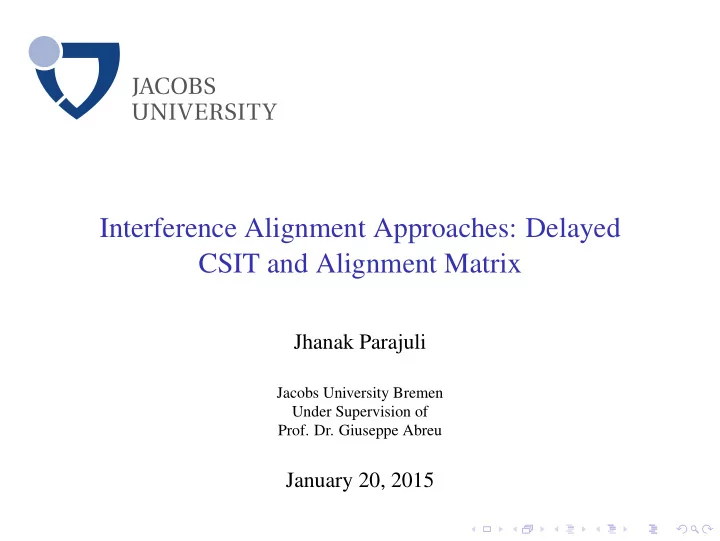

Interference Alignment Approaches: Delayed CSIT and Alignment Matrix Jhanak Parajuli Jacobs University Bremen Under Supervision of Prof. Dr. Giuseppe Abreu January 20, 2015
Motivation ◮ INTERFERENCE: A major problem in multi-user network. ◮ C = d log ( SNR )+ olog ( SNR ) . ◮ At high SNR, problem of capacity characterization= optimization of d . ◮ Interference Alignment is the approach to obtain the optimum d . ◮ In a K -User SISO interference channel optimum d = K 2 ,Each user gets half the cake, regardless of the number of users. ◮ Interference is not a major problem anymore. ◮ IA aligns all the interference in a common lower dimensional space.
An Example Scheme 3- User MIMO IA H 13 V 3 span ( H 12 V 2 ) = span ( H 13 V 3 ) at Rx1 . . . . . . H 12 V 2 H 11 H − 1 V 1 RX 1 = ⇒ V 2 12 H 13 V 3 TX 1 H 21 H 12 H 11 V 1 N 1 Antennas M 1 Antennas H 31 H 13 H 23 V 3 H 22 V 2 . . . . . . H 21 V 1 span ( H 21 V 1 ) = span ( H 23 V 3 ) at Rx2 H 22 V 2 RX 2 TX 1 H 32 N 2 Antennas H − 1 M 2 Antennas = ⇒ V 3 23 H 21 V 1 H 32 V 2 . . . . . . H 31 V 1 H 23 V 3 RX 3 H 33 TX 1 span ( H 31 V 1 ) = span ( H 32 V 2 ) at Rx3 N 3 Antennas M 3 Antennas H 33 V 3 H − 1 = ⇒ V 1 31 H 32 V 2 ◮ Requirement of global channel knowledge. ◮ Complexity increases H − 1 31 H 32 H − 1 = ⇒ V 1 12 H 13 V 3 with increasing H − 1 31 H 32 H − 1 12 H 13 H − 1 = ⇒ V 1 23 H 21 V 1 number of users. � H − 1 31 H 32 H − 1 12 H 13 H − 1 � ⇒ V 1 = eigv 23 H 21
Research Area Approaches to mitigate the requirement of global channel knowledge ◮ Approach I: Design iterative algorithms minimizing the Leakage interference and maximizing the received power ( Hybrid Optimization). Requires only the distributed channel knowledge. ◮ Approach II: Instantaneous CSIT is difficult to achieve. Delayed CSIT is shown to improve the DoF using the concept of IA in MISO-BC by Maddah Ali and Tse in their latest works. Our research works on MISO-IFBC with delayed CSIT. K ◮ We suggest that the achievable per cell DoF converges to K + 1 in the case when M = K with delayed CSIT known perfectly. The DoF per cell approaches 1 as the number of users in each cell approach to infinity. ◮ Approach III: USe of Alignment Matrix, the concept used in Non-linear manifold learning. Transmitters only require to know the local projection matrices.
Alignment Matrix The AM obtained from the sub-matrices Z 1 ∈ C c 1 × l , ··· , Z s ∈ C c s × l of any matrix Z ∈ C N × l is defined as . . . s ∑ Φ = P i , TX 2 i = 1 M 2 Antennas H 22 . . . where P i is obtained by embedding P ⊥ RX 2 Z i into C N × N according to the position of N 2 Antennas H 21 H 32 . . . the rows of Z i . TX 1 M 1 Antennas H 31 H 23 P i = [( I N ) ( J i , : ) ] T P ⊥ Z i ( I N ) ( J i , : ) ∈ C N × N , . . . RX 3 N 3 Antennas P ⊥ H 33 Z i = I − P Z i is the projection onto the . . . Desired Channel orthogonal complement of range of Z i TX 3 Interference Channel and P Z i = Z i Z † i is the orthogonal M 3 Antennas projection onto the range of Z i , while Z † i represents the Moore-Penrose pseudo inverse of Z i .
Recommend
More recommend